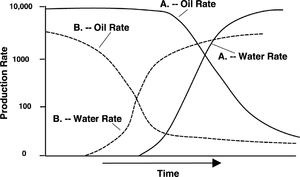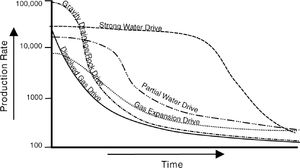Reservoir drive mechanisms
| Exploring for Oil and Gas Traps | |

| |
| Series | Treatise in Petroleum Geology |
|---|---|
| Part | Predicting the occurrence of oil and gas traps |
| Chapter | Predicting reservoir system quality and performance |
| Author | Dan J. Hartmann, Edward A. Beaumont |
| Link | Web page |
| Store | AAPG Store |
The reservoir drive mechanism supplies the energy that moves the hydrocarbon located in a reservoir container toward the wellbore as fluid is removed near the wellbore. There are five common drive mechanisms:
- Water drive
- Gas expansion
- Solution gas
- Rock or compaction drive
- Gravity drainage
One type usually dominates, but drive types can occur in combination. Depending on the drive mechanism, characteristic recovery efficiencies can be expected for a given reservoir.
Water drive
A strong water drive provides very good pressure support from the aquifer (100% voidage replacement) with minimal pressure drop at the wellbore. The aquifer water expands slightly, displacing the oil or gas from the reservoir toward the borehole as pressure drops around the borehole. This mechanism exists only where the aquifer is of equal or better quality than the reservoir and has a much larger volume than the reservoir (about 10 times) or is in communication with surface recharge. A strong water drive is more effective in oil reservoirs than in gas reservoirs. On a semi-log plot of production decline, the curve tends to be flat.
In fields where the aquifer is smaller and/or has lower quality, there is limited expansion of water into the reservoir as oil or gas is withdrawn. This is a partial water drive.
Figure 1 depicts typical decline curves for a wellbore draining a reservoir system with a strong water drive (A) and a partial water drive (B).
Partial water drive
A partial water drive results where an aquifer has poorer quality in terms of pore geometry or has limited volume. When the water support diminishes, the hydrocarbon production rate drops more rapidly than in a reservoir with a strong water drive and recovery is reduced. Its production decline curve trends more concave upward on a semi-log plot than a decline curve for a strong water drive.
Gas expansion
In reservoir systems with little or no water drive, gas expansion often provides the energy necessary to move hydrocarbons to the wellbore. Free gas in a gas reservoir or in the gas cap of an oil reservoir expands to replace produced hydrocarbons. In an oil system, this expansion slows the rate of fluid pressure drop in the reservoir and supports hydrocarbon production. Pressure drops in proportion to the volume of hydrocarbon removed from the reservoir and the quality of the reservoir. Reservoirs with gas expansion drives have, at most, a limited aquifer.
Solution gas
Crude oil under high pressure can contain large amounts of dissolved gas. The more gas there is in solution, the more compressible the oil. In oil reservoirs with little or no water drive, reservoir energy to drive the oil toward the wellbore can be supplied by expansion of the oil due to gas expanding in solution. This is a solution gas (or dissolved gas or depletion) drive. When pressure drops below the bubble point in the reservoir, small, disconnected gas bubbles form in pores, also pushing the oil toward the wellbore. At about 5–10% free gas in the reservoir, the bubbles coalesce and the gas moves toward the wellbore as a separate flowing phase. When this happens, oil production drops and gas production increases rapidly because of the increased relative permeability to gas.
Rock drive
As reservoir fluid pressure declines, the pressure on the solids, or net confining pressure (Pnc), increases because pore fluid pressure carries less of the weight of the overburden. Some reservoirs respond to the increase in Pnc by the collapse of the pore space. This can be an efficient way to expel hydrocarbons. Rock drive is common in shallow reservoirs or in reservoirs with unconsolidated sediments. It can also be expected to occur where porosity has been held open by high fluid pressures. Good examples of high pressure and unconsolidated reservoirs are some Danian Chalk reservoirs of the North Sea.
Gravity drainage
In gravity drainage, oil drains downward through a reservoir under the influence of gravity. This requires high vertical permeability or steeply dipping beds and thus is common in fractured reservoirs. Efficiency can be surprisingly high (75%+), especially where beds have steep dip, the oil has low viscosity, and the oil draining from the top of the column is replaced by exsolved gas.
Combination
Drive mechanisms can occur in combination. For instance, a gas expansion drive is commonly accompanied by a partial water drive. Water drives can be enhanced by imbibition effects, a minor drive type. Undersaturated oil reservoirs can begin producing by solution gas drive, then change to partial water drive when the energy from the dissolved gas is reduced to the point where it no longer is effective.
We sometimes can recognize combined drives from production decline curves, especially when oil, gas, and water are all plotted by rate. All plots of individual wells from a field should have common horizontal and vertical scales so they can be compared from well to well.
Decline curves for drive types
Analysis of production decline curve shape can provide a good indication of the dominant drive mechanism. Figure 2 compares typical production decline curves for the different drive mechanisms described above for a reservoir with approximately the same pore volume. It assumes all other factors are normalized.
See also
- Reservoir system
- Analyzing a reservoir system
- Defining flow units and containers
- Predicting reservoir drive mechanism

